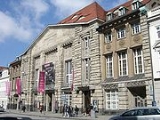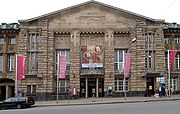
Theater Lübeck
Encyclopedia
.jpg) |
 |
.jpg) |
The Theater Lübeck (formerly Stage of the Hansestadt Lübeck, colloquially Stadttheater) is one of the largest theater
Theater (structure)
A theater or theatre is a structure where theatrical works or plays are performed or other performances such as musical concerts may be produced. While a theater is not required for performance , a theater serves to define the performance and audience spaces...
s in the German
Germany
Germany , officially the Federal Republic of Germany , is a federal parliamentary republic in Europe. The country consists of 16 states while the capital and largest city is Berlin. Germany covers an area of 357,021 km2 and has a largely temperate seasonal climate...
state of Schleswig-Holstein
Schleswig-Holstein
Schleswig-Holstein is the northernmost of the sixteen states of Germany, comprising most of the historical duchy of Holstein and the southern part of the former Duchy of Schleswig...
. It is managed by Theater Lübeck GmbH, a state-owned company of the Hansestadt Lübeck
Lübeck
The Hanseatic City of Lübeck is the second-largest city in Schleswig-Holstein, in northern Germany, and one of the major ports of Germany. It was for several centuries the "capital" of the Hanseatic League and, because of its Brick Gothic architectural heritage, is listed by UNESCO as a World...
.
Structure
The Theater was built in 1908 in the Art NouveauArt Nouveau
Art Nouveau is an international philosophy and style of art, architecture and applied art—especially the decorative arts—that were most popular during 1890–1910. The name "Art Nouveau" is French for "new art"...
style, on the site of an 18th century theater on the Beckergrube in Lübeck's Old City. It was designed by Martin Dülfer
Martin Dülfer
Martin Dülfer was a German architect.He taught as a professor at the Technische Hochschule Dresden .-Works:* The Stadttheater in Meran, Italy...
and construction was funded by local businessman and philanthropist Emil Possehl. The reliefs
Relief
Relief is a sculptural technique. The term relief is from the Latin verb levo, to raise. To create a sculpture in relief is thus to give the impression that the sculpted material has been raised above the background plane...
on the sandstone
Sandstone
Sandstone is a sedimentary rock composed mainly of sand-sized minerals or rock grains.Most sandstone is composed of quartz and/or feldspar because these are the most common minerals in the Earth's crust. Like sand, sandstone may be any colour, but the most common colours are tan, brown, yellow,...
facade
Facade
A facade or façade is generally one exterior side of a building, usually, but not always, the front. The word comes from the French language, literally meaning "frontage" or "face"....
are the work of sculptor Georg Roemer. The relief in the center depicts Apollo
Apollo
Apollo is one of the most important and complex of the Olympian deities in Greek and Roman mythology...
and the Nine Muses, with Comedy
Comedy
Comedy , as a popular meaning, is any humorous discourse or work generally intended to amuse by creating laughter, especially in television, film, and stand-up comedy. This must be carefully distinguished from its academic definition, namely the comic theatre, whose Western origins are found in...
and Tragedy
Tragedy
Tragedy is a form of art based on human suffering that offers its audience pleasure. While most cultures have developed forms that provoke this paradoxical response, tragedy refers to a specific tradition of drama that has played a unique and important role historically in the self-definition of...
represented on either side. The gable end supports depicting Caryatid
Caryatid
A caryatid is a sculpted female figure serving as an architectural support taking the place of a column or a pillar supporting an entablature on her head. The Greek term karyatides literally means "maidens of Karyai", an ancient town of Peloponnese...
s and Atlas
Atlas (mythology)
In Greek mythology, Atlas was the primordial Titan who supported the heavens. Although associated with various places, he became commonly identified with the Atlas Mountains in north-west Africa...
are the work of Hamburg
Hamburg
-History:The first historic name for the city was, according to Claudius Ptolemy's reports, Treva.But the city takes its modern name, Hamburg, from the first permanent building on the site, a castle whose construction was ordered by the Emperor Charlemagne in AD 808...
plasterer Karl Weinberger. The facade received a complete restoration in the 1990s.
History
Public interest in theatrical works and operaOpera
Opera is an art form in which singers and musicians perform a dramatic work combining text and musical score, usually in a theatrical setting. Opera incorporates many of the elements of spoken theatre, such as acting, scenery, and costumes and sometimes includes dance...
arose in Lübeck in the early days of the Age of Enlightenment
Age of Enlightenment
The Age of Enlightenment was an elite cultural movement of intellectuals in 18th century Europe that sought to mobilize the power of reason in order to reform society and advance knowledge. It promoted intellectual interchange and opposed intolerance and abuses in church and state...
.
The first opera production in the city was on June 2 1746 in the house of master craftsman
Master craftsman
A master craftsman or master tradesman was a member of a guild. In the European guild system, only masters were allowed to be members of the guild....
Schröder Ecke on the Königstraße. The predecessor to the current building was built in 1752. The transition of the company to the city in the 19th century is described by Thomas Mann
Thomas Mann
Thomas Mann was a German novelist, short story writer, social critic, philanthropist, essayist, and 1929 Nobel Prize laureate, known for his series of highly symbolic and ironic epic novels and novellas, noted for their insight into the psychology of the artist and the intellectual...
in his novel Buddenbrooks
Buddenbrooks
Buddenbrooks was Thomas Mann's first novel, published in 1901 when he was twenty-six years old. The publication of the 2nd edition in 1903 confirmed that Buddenbrooks was a major literary success in Germany....
.
Prominent conductors that began their careers in Lübeck include Hermann Abendroth
Hermann Abendroth
Hermann Paul Maximilian Abendroth was a German conductor.-Early life:Abendroth was born on 19 January 1883, at Frankfurt, Germany, belonging to a family which had already produced other artistic figures of divers disciplines...
, Wilhelm Furtwängler
Wilhelm Furtwängler
Wilhelm Furtwängler was a German conductor and composer. He is widely considered to have been one of the greatest symphonic and operatic conductors of the 20th century. By the 1930s he had built a reputation as one of the leading conductors in Europe, and he was the leading conductor who remained...
and Christoph von Dohnányi
Christoph von Dohnányi
Christoph von Dohnányi is a German conductor of Hungarian ancestry.- Youth and World War II :Dohnányi was born in Berlin, Germany to jurist Hans von Dohnányi and Christine Bonhoeffer. His uncle on his mother's side was Dietrich Bonhoeffer, a Lutheran pastor and theologian/ethicist...
.
Theater
The theater offerings cover all kinds of cultural activities, including operaOpera
Opera is an art form in which singers and musicians perform a dramatic work combining text and musical score, usually in a theatrical setting. Opera incorporates many of the elements of spoken theatre, such as acting, scenery, and costumes and sometimes includes dance...
, ballet
Ballet
Ballet is a type of performance dance, that originated in the Italian Renaissance courts of the 15th century, and which was further developed in France and Russia as a concert dance form. The early portions preceded the invention of the proscenium stage and were presented in large chambers with...
, chamber music
Chamber music
Chamber music is a form of classical music, written for a small group of instruments which traditionally could be accommodated in a palace chamber. Most broadly, it includes any art music that is performed by a small number of performers with one performer to a part...
, and plays, as well as concerts of the Lübeck Philharmonic Orchestra
Orchestra
An orchestra is a sizable instrumental ensemble that contains sections of string, brass, woodwind, and percussion instruments. The term orchestra derives from the Greek ορχήστρα, the name for the area in front of an ancient Greek stage reserved for the Greek chorus...
.
The theater management has included Karl Vibach (1968-1978), Hans Thoenies (1978-1991), Dietrich von Oertzen (1991-2000) and Marc Adam (2000-2007). Since 2007 the theater has been managed by committee.
50% of the proceeds of Theater Lübeck GmbH go to the city of Lübeck. 12.5% each go to the regional governments of the surrounding districts of Herzogtum Lauenburg and Nordwestmecklenburg
Nordwestmecklenburg
Nordwestmecklenburg is a Kreis in the north-western part of Mecklenburg-Vorpommern, Germany. It is situated on the coast of the Baltic Sea and borders on Schleswig-Holstein to the west...
, the Chamber of Commerce
Chamber of commerce
A chamber of commerce is a form of business network, e.g., a local organization of businesses whose goal is to further the interests of businesses. Business owners in towns and cities form these local societies to advocate on behalf of the business community...
("Kaufmannschaft"), and the Gesellschaft der Theaterfreunde e. V. Lübeck (Friends of the Theater).

